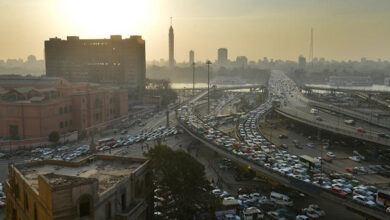Cairo, the palimpsest city with multiple layers of dense continuous inhabitation, is currently seeking reconstructive plastic surgery. With ailing infrastructure and rampant informality, the city seeks to confront its past negligence with planning. Bumper-to-bumper, stop-and-start congestion is a fact of life for Cairenes commuting daily in and out of the center on the city's spinal chord, the 6 October freeway. Coal. Gas. Gridlock. Smog. Mubarak. Delays. Tashreefa. Words on the tip of every Cairene tongue. Leviathan traffic jams regularly grip not just 6 October, but every freeway in this dense and continuously sprawling city.
From outdated governmental policies, to the more simplistic and cynical taxi-driver "solution" of an atomic bomb in Ramses Square, to recent competitions that superficially tackle the city’s urban problems, there have not yet been any satisfactory approaches to developing Cairo as a modern urban center with public spaces, housing for its lower classes and an efficient network of mass transport.
In the past century alone, Cairo's population has grown by about 890 percent, fueled partly by an influx from rural areas. In this period, the city has witnessed changes in government from a colonial occupation, to a pseudo-colonial monarchy, to a quasi-socialist military regime, to its present-day authoritarian state. Each regime has brought its own vision of radical economic change, often based on political alignments–from colonial, to socialist, to the contemporary neoliberal free-market approach. Under the latter, the government’s approach to city planning has varied from a laissez-faire attitude (turning away from its social contract and provisionary role towards society’s underprivileged segments), to aggressively pursuing a “disneyfication” of monuments and historic neighborhoods for touristic consumption, to promoting the rapid construction of suburban desert islands reserved for the upper classes.
The failure to plan effectively, particularly for the poor, is most vividly seen in the spread of informal developments on scarce agricultural land and the lack of efficient mass transport systems–the latter hampering the connectivity of the city and leading to unprecedented levels of car traffic and pollution. This, in turn, impedes direct foreign investment and economic growth–both major concerns for the current neoliberal government–and makes a solution to traffic congestion, particularly in the city center, a matter of burning urgency.
At the epicenter of Cairo’s traffic problems lie Ramses, Ataba, Tahrir, and Opera squares–the nodal points where movement axes intersect between the north and south of the Nile Valley.
Ramses is one of the busiest and most polluted intersections in Cairo, with millions of vehicles and pedestrians pulsing through it everyday. A recent article in The New York Times notes that the noise levels in the square reaches 95 decibels, which is only slightly quieter than standing next to a jackhammer. Here is where rural migrants are ushered into the ultra-frenetic city, often where they start-off making their living selling nick-knacks and ultimately providing a secondary layer of noise. Here is where ten modes of transportation intersect and pour out unto further congestion in the two neighboring squares of Ataba and Tahrir.
Capitalizing on the desire to find a permanent solution to Cairo’s traffic problem, the Egyptian government commissioned the National Organization for Urban Harmony (NOUH)–an organization created by the Ministry of Culture in 2004 to promote “the values of beauty all over Egyptian urban space”–to run two international urban design competitions for Ataba and Ramsis squares.
In its terms of reference, the Ataba competition laments the loss of “what was once the pride and joy of Khedive Ismail’s vision of a glorious ‘Paris of the East’”. Laden with an unhealthy nostalgia for the past and a desire to recreate a sense of the belle epoque for touristic consumption, both competitions seek to superficially “beautify” the squares and somehow find solutions to traffic problems.
But these competitions have typically been marked by a few problems of their own. Surely traffic congestion in Ramses should be relieved and broader transportation solutions for the city found, but this requires a participatory setting that incorporates the diverse voices of those who use the square. Jesse McClelland rightly asks, in an op-ed for Al-Masry Al-Youm, “Was a closed-door competition [for Ramses square] juried by specialists, and overseen by a journalist, the best way to realize “human development” principles?”
The winning proposals for the Ramses contest clearly demonstrate the huge lack of community involvement in the design. Central to the life of the square, for instance, are informal street vendors whose livelihoods depend on the square's foot traffic.
“Do you think you could ask…that they take us into consideration when they are re-planning the square? Perhaps they could set up little booths for us,” remarked one vendor speaking to Al-Ahram Weekly.
Participatory planning is not only necessary to curb the effects of informality but also to ensure the real satisfaction of the actual users, as opposed to passing tourists. The "park-mall" proposals in the Ramses competition, for example, neglected the myriad informal uses of public space that do not appear anywhere on "clean" drawings of the revamped square.
Finally, the larger problem with these competitions derives from what they ultimately set out to achieve, which in the end is too much. The statement on NOUH’s website explaining the jury decision for Ramses criticizes each of the winning proposals for “not solving the traffic problem.” But reorganization of Cairo's traffic problems will require larger macro-solutions that work in tandem with surgical interventions at congested nodal points–solutions which a closed-door competition can only highlight but cannot concretely solve.
The problems of Ramses, Ataba, Opera, and the larger problems of circulation in Cairo, are the result of urban governmental policies that encourage the thin spread of suburbanization to eastern and western satellite towns while failing to provide efficient mass transportation networks. This is fundamentally an issue of government policy that will be solved neither by an urban design competition, nor by an atomic bomb.
Manar Moursi is an architect with a dual degree in Architecture and Urban Planning from Princeton University.




